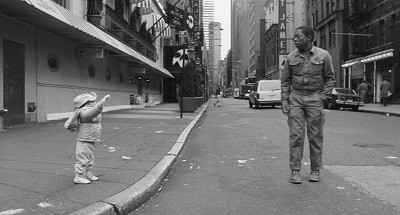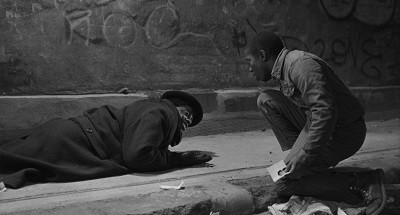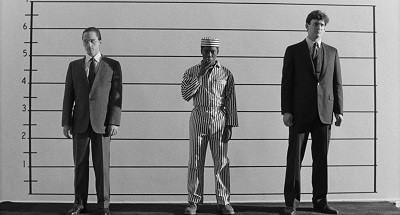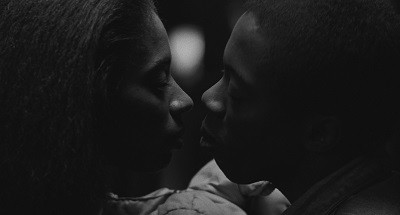| Reviews & Columns |
|
Reviews DVD TV on DVD Blu-ray 4K UHD International DVDs In Theaters Reviews by Studio Video Games Features Collector Series DVDs Easter Egg Database Interviews DVD Talk Radio Feature Articles Columns Anime Talk DVD Savant Horror DVDs The M.O.D. Squad Art House HD Talk Silent DVD
|
DVD Talk Forum |
|
|
| Resources |
|
DVD Price Search Customer Service #'s RCE Info Links |
|
Columns
|
|
|
Sidewalk Stories
 On the streets of New York City, thousands of homeless people try to get by, turning to whatever skills they have to try and earn another meal. Many perform music, some dance, others do card tricks or play betting games. One of them, the Artist (Charles Lane) sits on the corner with his advertising board featuring a trio of celebrity sketches, offering to do people's portraits for only a dollar. When a couple has the Artist paint their Child (Nicole Alysia), the Artist is happy to do so, but the couple's fight over the husband's gambling is a preview of what's to come. Just a few hours later, the Artist is walking by an alley when he sees a gang of street thugs murder the man for coming up short one time too many. With the mother nowhere to be found, the Artist accepts the responsibility of caring for the Child until he can track her down.
On the streets of New York City, thousands of homeless people try to get by, turning to whatever skills they have to try and earn another meal. Many perform music, some dance, others do card tricks or play betting games. One of them, the Artist (Charles Lane) sits on the corner with his advertising board featuring a trio of celebrity sketches, offering to do people's portraits for only a dollar. When a couple has the Artist paint their Child (Nicole Alysia), the Artist is happy to do so, but the couple's fight over the husband's gambling is a preview of what's to come. Just a few hours later, the Artist is walking by an alley when he sees a gang of street thugs murder the man for coming up short one time too many. With the mother nowhere to be found, the Artist accepts the responsibility of caring for the Child until he can track her down.
Sidewalk Stories is a sweet and touching love letter to silent comedy, one which makes up for any shortcomings in terms of scale or orchestration -- even the cheaper of the Chaplin films Lane is referencing here had more elaborate and involved physical comedy routines than anything seen here -- with an excess of unique and vibrant personality. Lane injects the slapstick with a dose of social commentary, and manages to weave it into the world that surrounds the Artist and the Child rather than hit the viewer over the head with it, building a vivid picture of his story's setting and the people who inhabit it.
Although I have never been to New York, I would not be surprised to hear that Sidewalk Stories is one of the great New York films. The movie's black-and-white photography vividly captures the contemporary sight of constant construction, graffiti, and crowded streets, while also muting the elements that have since gone out of style. Much of the 1980s (at least today) is defined by gaudy colors, but Stories seems generically modern, with the focus redirected to things that are still the same rather than how much has changed. Lane doesn't focus on landmarks, but there's a very specific vibe to the city that comes through in the people he captures and the tone those people create. The film's slight timelessness is also aided by composer Marc Marder, who mixes playful flutes and clarinets to evoke the silent era, while also including electric guitars for a bit of the contemporary.
 Throughout, the Artist's homelessness informs the story from below, always present in scenes but rarely serving as the focal point. He lives in an abandoned building with some of the comforts of home, and when he is invited up to someone's house for dinner, he sneaks in a shower while the host is occupied. One night, he returns home to find it has been demolished, and is forced to retreat to a homeless shelter. On the next night, the shelter is full, and he treks all the way across town to a different one, only to find it's closed too. Despite his troubles, the Artist refuses to impose himself on others, insistently charging only a dollar for his portraits when one grumpy neighbor demands $50. When he needs clothes for the child, he sneaks into a store and shoplifts them, only to slip money in the pocket of the owner later.
Throughout, the Artist's homelessness informs the story from below, always present in scenes but rarely serving as the focal point. He lives in an abandoned building with some of the comforts of home, and when he is invited up to someone's house for dinner, he sneaks in a shower while the host is occupied. One night, he returns home to find it has been demolished, and is forced to retreat to a homeless shelter. On the next night, the shelter is full, and he treks all the way across town to a different one, only to find it's closed too. Despite his troubles, the Artist refuses to impose himself on others, insistently charging only a dollar for his portraits when one grumpy neighbor demands $50. When he needs clothes for the child, he sneaks into a store and shoplifts them, only to slip money in the pocket of the owner later.
That said, the core of the story is the relationship that develops between the Artist and the Child, and it's hard to imagine even the grumpiest, most bitter viewers not having their hearts melted by Nicole Alysia, whose natural curiosity and earnestness radiates from her wide, expecting eyes. In real life, Alysia is Lane's daughter, and their bond is evident in every one of their scenes together: dancing in the Artist's temporary home; examining her drawings of Mickey Mouse, Big Bird, and Bert and Ernie; or sitting down for a nice dinner. The Artist also connects with the Young Woman (Sandye Wilson), who stops by his easel for a portrait, and is taken by his kindness, as well as his devotion to caring for the Child. Although there are never any cards with dialogue on them, the performers still speak, and Wilson conveys so much through her mannerisms. She's also hilarious in two scenes where she gets to show off her strength, one of which is a dream sequence.
In the film's final moments, Lane makes one of his boldest artistic choices, the only instance where the film underlines its social message. It's a moment that will undoubtedly prompt a few eye rolls, but it's less an indictment of society as it is a comment relating to the film itself. The viewer is happy to spend time with the Artist, a charming man with a good heart, but he's still a homeless man, struggling to get by. Others may not be so lucky as to have a movie made of their winning exploits with an adorable little girl, but they're no less human.
 The Blu-ray
The Blu-ray
Sidewalk Stories comes in a minimalistic-looking package featuring black-and-white image of The Artist and The Child embracing one another, over a goldenrod backdrop. The back cover keeps things equally simple, with another single picture of The Artist and The Child playing, over the same backdrop, with simple, clean fonts and strong use of black and white throughout the text. The artwork is printed on a matte slipcover, with a sleeve inside the case with the same artwork, and the entire package comes in a dark gray transparent Blu-ray case. Some character portraits show through on the inside, and there is no insert. Note that the packaging displays A, B, and C logos -- those in other countries should feel safe importing it.
The Video and Audio
I can only imagine the pleasure those people will feel at seeing Carlotta's brand new 1.85:1 1080p AVC presentation, which is based off of a 2K restoration done from the original camera negative by L'Immagine Ritrovata of Bologna last year. The flaws first. I have a Japanese Blu-ray of Jim Jarmusch's Stranger Than Paradise, which exhibits a unique focus problem: it often looks as if two identical frames of the film were placed on top of each other, but slightly out of alignment, lowering the clarity and crispness of the picture. Stranger was also a black-and-white film produced in the 1980s, and this transfer exhibits the same anomaly from time to time, generally when the camera is moving. Some instances are worse than others, but most are brief. Based on the fact that I've seen this on only one other film, produced in the same format, from the same era, I'm going to guess this is an issue that has to do with the original photography rather than anything wrong with the transfer itself. You can see the worst example of this issue from Sidewalk Stories by clicking here.
That aside, the vast majority of this 25-year-old movie looks as if it could've been filmed yesterday. The degree of depth, detail, and clarity in most of the presentation offered here is exemplary. If DVDTalk gave out "Collector's Series" ratings to A/V, the video here would qualify without question, even with the inherent shortcomings in the original negative.  The degree to which the image has been fine-tuned is astonishing, with film grain both entirely visible yet so fine as to almost vanish. Sidewalk Stories is the best restoration or new transfer I've viewed this year, and possibly one of the most impressive restored transfers I've watched for DVDTalk.
The degree to which the image has been fine-tuned is astonishing, with film grain both entirely visible yet so fine as to almost vanish. Sidewalk Stories is the best restoration or new transfer I've viewed this year, and possibly one of the most impressive restored transfers I've watched for DVDTalk.
Sound is a restored DTS-HD Master Audio 2.0 track. Given this is a silent film recorded in stereo, the mastery of the sound can't be fairly compared to the video, but this is nonetheless a track that is entirely free of any problems or issues. At times, the music is reproduced with such boldness and clarity, I could have sworn I was listening to a live score -- there is not a single degree of hiss, crackle, pop, or muffling throughout the entire film. Of course, no subtitles or captions are included.
The Extras
The disc starts with an audio commentary by director, writer, and star Charles Lane, and composer (and orchestrator) Marc Marder. Sadly, this is a middling listening experience, with some information about the shoot and putting the film together mixed in with far too much of Lane inadvertently describing what is happening on screen, or with the music. There's some information to be gleaned here, for sure, but Lane is far too focused on the production rather than the concept and ideas that went into the making of the film. A bit disappointing.
This is followed by "Vibrations" (28:04, HD), an interview with Charles Lane and Marc Marder, conducted by film historian Greg Ford. This is much more of what I was looking for from the commentary, with Lane talking at length about his influences (The Kid was not the main source of inspiration), how he wanted to pay homage to silent films ("no histrionics"), the challenges of silent filmmaking, and the screenplay, which featured dialogue. Marder speaks about developing the themes he created for the short film years before, the styles he attempted to bring to the film. Lane jumps back in during Marder's interview as well, to discuss their working relationship, and compliments him on decoding his ideas. Lane also discusses the challenges and working relationship with his daughter, as well as his decision to credit her as "Nicole Alysia" rather than "Nicole Alysia Lane." They also talk at length about the film's social commentary, and how things have changed since 1989 (and haven't). They cover most of the same subjects from the commentary -- go with this feature instead.
 The disc concludes with "A Place in Time" (34:21, HD), the short film that introduced the character of the Artist. Shot in 1977, nearly a decade before the feature, this is a darker, edgier piece focusing partially on gang violence. Right off the bat, a guy randomly hitting someone on the street with a hammer and leaving his body on the sidewalk. Moments later, Lane includes a scene of a trio of thugs pushing a man in a wheelchair into the road, coupled with a moment that appears to imply a rape, with no apparent story payoff. Another scene attempts to build a humorous fight scene around a man holding a knife to a woman's neck. The Artist is not caring for a child, but in love with a dancer (Francine Piggott) who stops to have her portrait done. It's similar to the feature's thread with the Young Woman, but doesn't quite capture as much atmosphere or emotion, with the romance playing more like a fling. However, the short's slapstick is funnier, including pratfalls and a scene where the Artist watches a very long argument. The piece arrives at a curiously dark ending that doesn't quite make sense. Still, this is an obvious and appreciated choice to round out the supplements on the disc.
The disc concludes with "A Place in Time" (34:21, HD), the short film that introduced the character of the Artist. Shot in 1977, nearly a decade before the feature, this is a darker, edgier piece focusing partially on gang violence. Right off the bat, a guy randomly hitting someone on the street with a hammer and leaving his body on the sidewalk. Moments later, Lane includes a scene of a trio of thugs pushing a man in a wheelchair into the road, coupled with a moment that appears to imply a rape, with no apparent story payoff. Another scene attempts to build a humorous fight scene around a man holding a knife to a woman's neck. The Artist is not caring for a child, but in love with a dancer (Francine Piggott) who stops to have her portrait done. It's similar to the feature's thread with the Young Woman, but doesn't quite capture as much atmosphere or emotion, with the romance playing more like a fling. However, the short's slapstick is funnier, including pratfalls and a scene where the Artist watches a very long argument. The piece arrives at a curiously dark ending that doesn't quite make sense. Still, this is an obvious and appreciated choice to round out the supplements on the disc.
A 2013 original theatrical trailer is also included.
Conclusion
The phrase "lost gem" is used on many movies, but Sidewalk Stories genuinely feels like a movie that hasn't quite had its day in the sun. Thanks to the spectacular new restoration, and (commentary aside) some strong supplements, this is a film that many people should have the joy of rediscovering. Highly recommended.
Please check out my other DVDTalk DVD, Blu-ray and theatrical reviews and/or follow me on Twitter.
|
| Popular Reviews |
| Sponsored Links |
|
|
| Sponsored Links |
|
|
| Release List | Reviews | Shop | Newsletter | Forum | DVD Giveaways | Blu-Ray | Advertise |
|
Copyright 2024 DVDTalk.com All Rights Reserved. Legal Info, Privacy Policy, Terms of Use,
Manage Preferences,
Your Privacy Choices | |||||||













